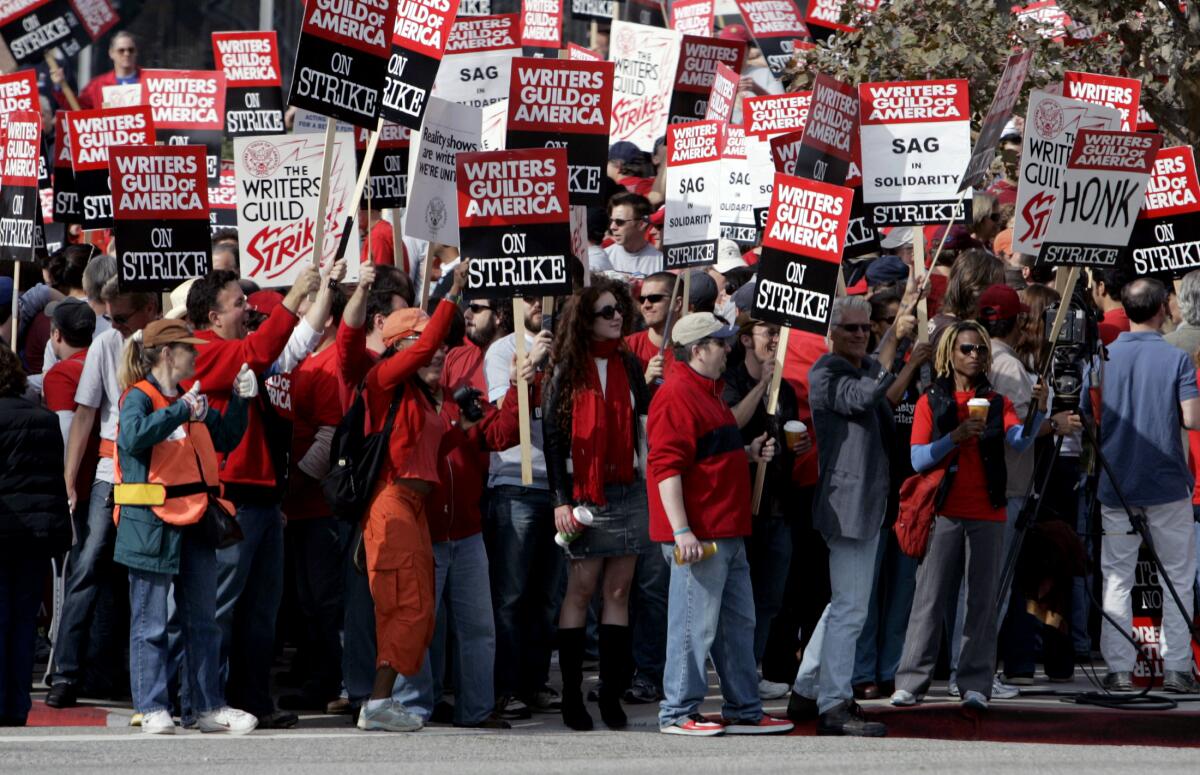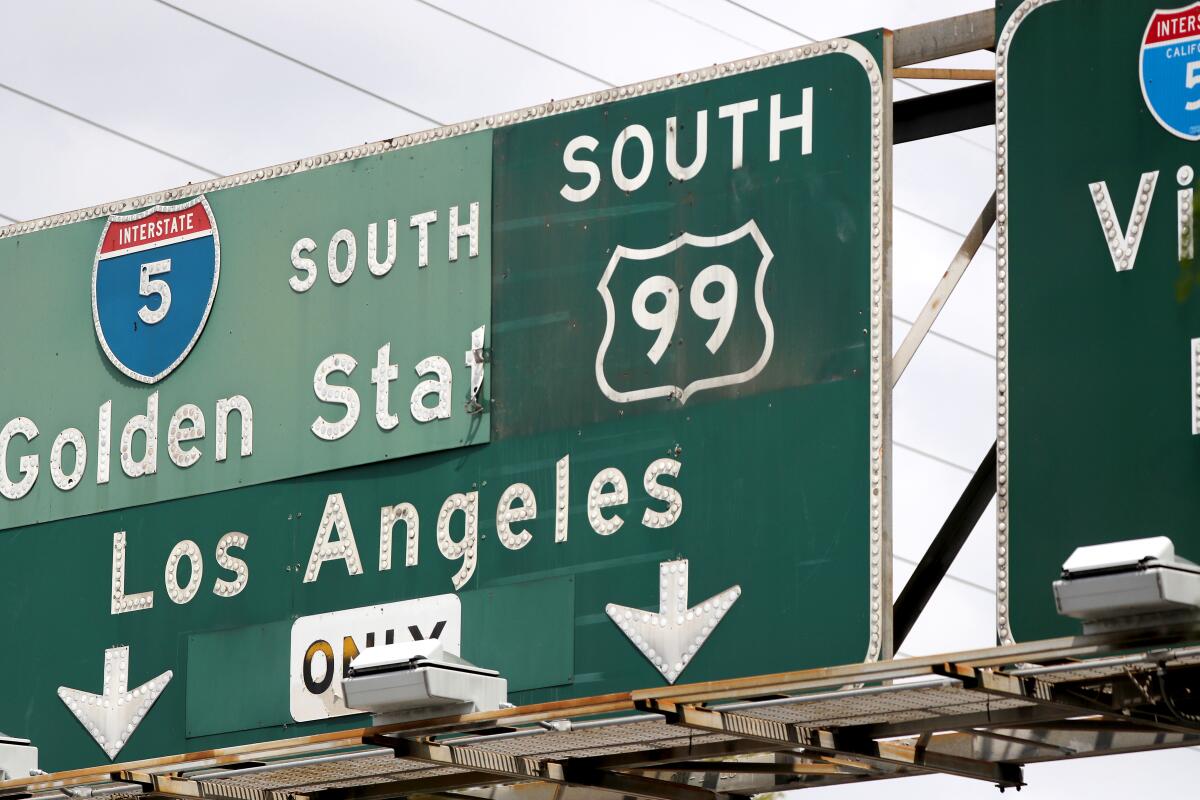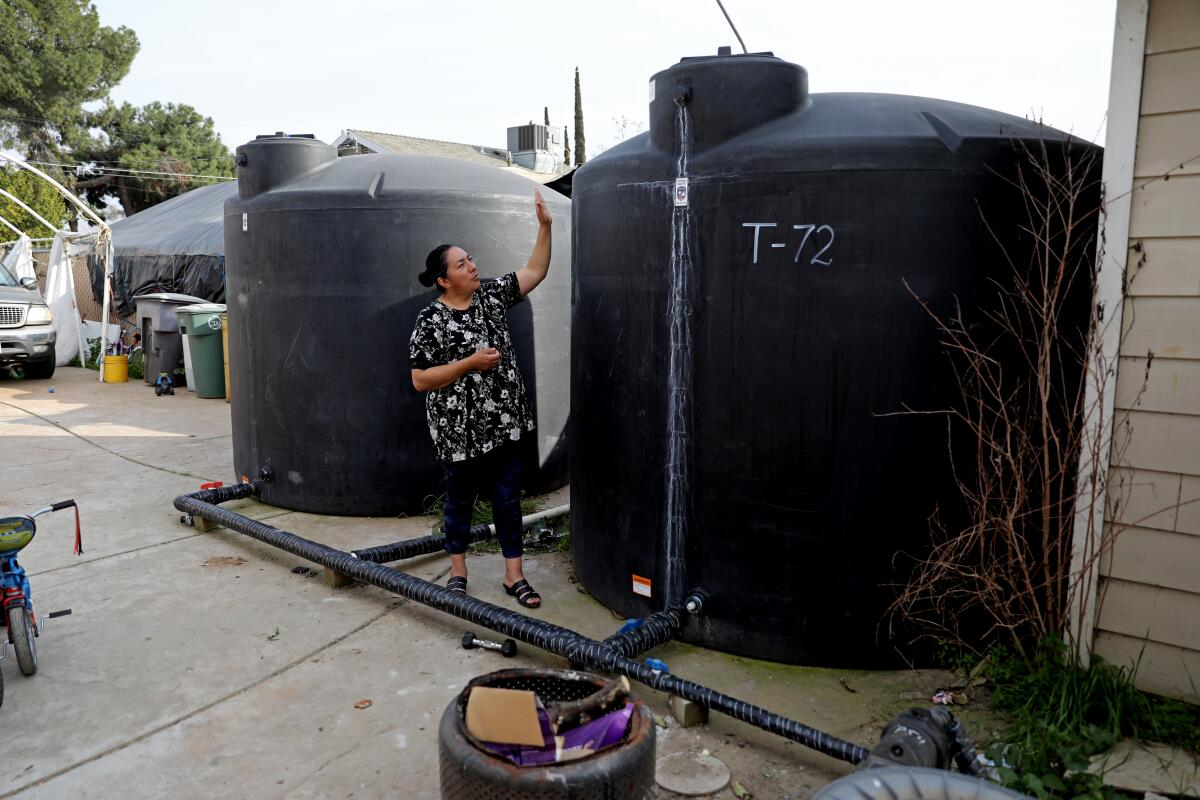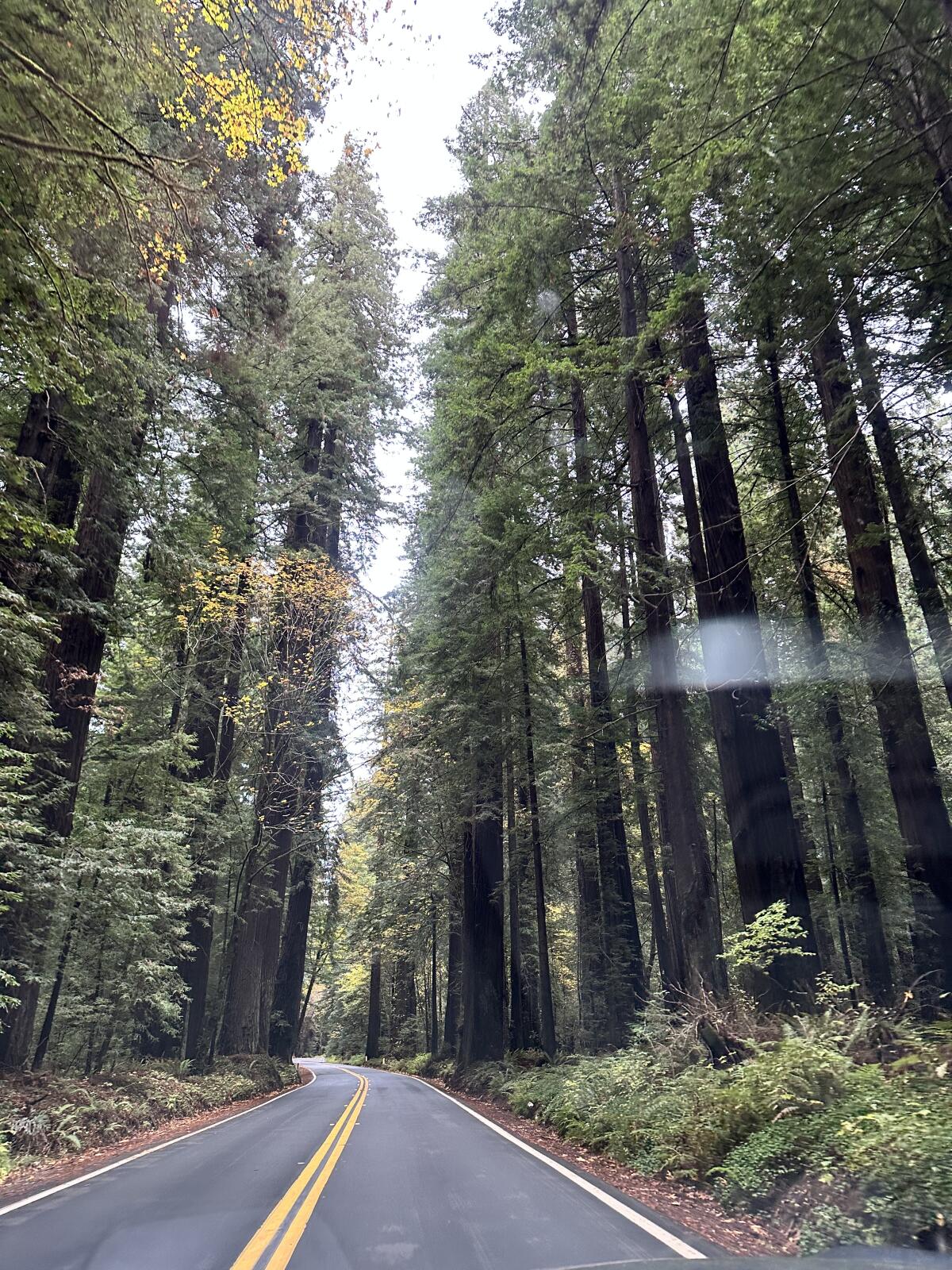4 things to know about the potential writers’ strike

- Share via
Good morning, and welcome to the Essential California newsletter. It’s Wednesday, April 19.
The Hollywood economic engine is one step closer to shutting down. On Monday, Writers Guild of America members voted by a historic margin — 98% to 2% — to approve a strike as negotiations between union leaders and the Alliance of Motion Picture and Television Producers stalled.
The alliance is made up of traditional studios like Walt Disney Co. and Warner Bros., but also includes the more recently added streaming giants Netflix, Amazon and Apple.
Writers are calling for higher wages and a full redesign of the residual payments process, which the age of streaming has thrown for a loop.
Their current three-year contract, which covers about 11,500 members, expires May 1. If the two sides can’t reach a deal by then, we could witness the first writer walkout in 15 years.
As thousands of writers and the major entertainment powerhouses prepare for the possibility of a work stoppage, here are four things to know about what’s happening and what’s next.
1) Streaming is at the heart of the fight
With network TV, cable channels, the big streaming services and smaller on-demand channels so new or niche you may not have heard of them (What is Tubi? Does anyone know?), there’s more to watch than ever before.
But that surge in content has depressed writer pay, WGA leaders argue. A recent union survey found that half of series writers now earn scale (the minimum episodic or weekly rate) compared with 33% during the 2013-14 season.
One key word you’ll read a lot in coverage of the possible strike is residuals. That’s the money writers traditionally earned when a show episode they wrote was re-aired on television.
But that traditional rerun structure doesn’t exist on platforms like Netflix. The residuals writers get for working on streaming shows — no matter how popular or acclaimed their work becomes — are a fraction of the broadcast model.
2) The impact of a writers’ strike would be felt beyond the production set
A work stoppage would quickly ripple through a major job sector and economic driver for the state. If the writers stop writing, there are no scenes to film, no sets to create, no actors to get camera-ready, no crews to feed. It also means less money for the state, which generates revenue through filming permits.
The 2007-2008 writer’s strike provides a glimpse at the possible economic impact, when California’s economy lost an estimated $2.1 billion.
A Milken Institute study conducted in the aftermath of that three-month strike projected a net loss of 37,700 jobs directly and indirectly tied to the entertainment industry.
The last strike also came amid the Great Recession. And though the current economic forecast isn’t as dire as it was 15 years ago, there are concerns that a similar downturn could materialize this year.
3) A strike could change your TV viewing options
What would a strike mean for your favorite shows?
Just like the last time, it would halt production and delay development. Daily and weekly programs, such as late night talk shows and “Saturday Night Live,” would disappear. You’d likely have to wait a while on the release of new shows or new seasons still in production.
Despite some of the chatter on Twitter, the last strike didn’t create so-called reality TV, though it did expand its on-air real estate. Times entertainment writers Meredith Blake and Yvonne Villarreal explained why:
Most of the producers who craft reality TV story lines are not affiliated with a union and will not be affected by a strike. The genre also tends to be cheaper and less time-consuming to produce than scripted TV, making it an ideal alternative during past work stoppages.
But a work stoppage of scripted shows would prove more complicated for reality TV production this time around, given how the genre has grown in the decade-plus since — and workers are growing more vocal about labor issues in the largely non-unionized workforce.
4) The will-they-won’t-they of the strike is further complicated by turmoil in the entertainment industry
Disney, Netflix, Warner Bros. and more have laid off thousands of workers amid an economic downturn rippling across the industry. Big firms are continuing to lose money on streaming — and now the belt-tightening is upon them.
“It’s going to be a tough environment for them to come to a deal quickly because of the dynamics with studios having to make some cost cuts,” David Smith, a professor of economics at Pepperdine University’s Graziadio Business School, told Times reporters last week. “We’re still in this uncertain period about where digital streaming is going to end up.”
Netflix Co-CEO Ted Sarandos recently addressed the strike at the company’s first-quarter meeting.
“We don’t want a strike,” he said, according to Deadline, adding: “If there’s a strike, and we want to work really hard to make sure we can find a fair and equitable deal so we can avoid one, but if there is one, we have a large base of upcoming shows and films from around the world.”
And now, here’s what’s happening across California:
Note: Some of the sites we link to may limit the number of stories you can access without subscribing.
L.A. STORIES
The teachers union for educators in Los Angeles schools have reached a tentative agreement with the district that will provide a 21% wage increase over roughly three years. The deal — which still needs to be ratified by union members and approved by the school board — also includes slight decreases in class sizes (about two students per class). Los Angeles Times
Some drivers on the 134 Freeway got a possibly confusing glimpse of highway history Tuesday, when part of a 5 Freeway sign fell down, revealing an old U.S Route 99 sign underneath. That route ran from the Mexican border up to Washington state from 1926 to 1972, before being largely replaced with the current 5 Freeway. Los Angeles Times

Check out "The Times" podcast for essential news and more
These days, waking up to current events can be, well, daunting. If you’re seeking a more balanced news diet, “The Times” podcast is for you. Gustavo Arellano, along with a diverse set of reporters from the award-winning L.A. Times newsroom, delivers the most interesting stories from the Los Angeles Times every Monday, Wednesday and Friday. Listen and subscribe wherever you get your podcasts.
POLITICS AND GOVERNMENT
Sen. Dianne Feinstein won’t be getting a temporary replacement on the Senate Judiciary Committee, Senate GOP leader Mitch McConnell said Tuesday. Feinstein has been absent from the U.S. Capitol for months while she recovers from shingles. Her absence has caused headaches for fellow Democrats, as it hinders their ability to confirm President Biden’s judicial nominees. Los Angeles Times
Despite an influx of more than $20 billion over the last several years, the homelessness crisis has grown dramatically. Now a bipartisan group of legislators is calling on a large-scale state audit to find out how all that money has been spent. CalMatters
CRIME, COURTS AND POLICING
Sixteen female athletes who sued San Diego State University last year, alleging they received less scholarship money than male athletes, can move forward with their Title IX lawsuit, a federal judge ruled last week. The women and their attorneys provided data alleging San Diego State deprived its female athletes of more than $5.36 million in financial aid. San Diego Union-Tribune
Federal officials have opened an investigation after video of a man jumping into the water of San Francisco’s Pier 39 and harassing its famous sea lions went viral. The short clip circulated on social media shows the man knock back a canned beverage, backflip into the water and then swim to the floating docks, sending dozens of sea lions scattering into the water. Harassing or harming marine mammals is illegal under the Marine Mammal Protection Act of 1972 and punishable with fines and/or jail time. San Francisco Chronicle
Support our journalism
HEALTH AND THE ENVIRONMENT
California’s winter storms made little difference for many of the San Joaquin Valley residents whose wells went dry after three years of historic drought. As Times staff writer Ian James reports, their plight “has sparked heated criticism of the state government for not doing more to limit excessive pumping by large farms.” Los Angeles Times

With old age and climate change killing California’s trees, UC Davis researchers are looking at ways to replace vulnerable local species and replenish urban forests. To explore that, they’re turning to Texas trees as a possible solution. The Mercury News
Humans continue to make messes of California’s beaches and the Ocean Conservancy continues to clean them up. The environmental group’s most recent report lists the most common items of trash collected at beaches across the state. The top spot went to cigarette butts. NBC Los Angeles
Free online games
Get our free daily crossword puzzle, sudoku, word search and arcade games in our new game center at latimes.com/games.
AND FINALLY
Today’s California landmark is from Daniel Kowalski of San Diego: a mid-morning view of Avenue of the Giants.

Daniel writes:
To the left of the frame is the main stem of the Eel River and to the right is U.S.101. Many of these coastal redwoods (Sequoia sempervirens) are over 300 feet tall and have been alive since pre-Columbian times.
What are California’s essential landmarks? Fill out this form to send us your photos of a special spot in California — natural or human-made. Tell us why it’s interesting and what makes it a symbol of life in the Golden State. Please be sure to include only photos taken directly by you. Your submission could be featured in a future edition of the newsletter.
Please let us know what we can do to make this newsletter more useful to you. Send comments to essentialcalifornia@latimes.com.
Sign up for Essential California
The most important California stories and recommendations in your inbox every morning.
You may occasionally receive promotional content from the Los Angeles Times.




